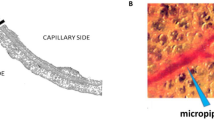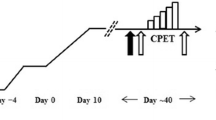Abstract
The pulmonary blood-gas barrier has a basic physiological dilemma. On the one hand it needs to be extremely thin for efficient gas exchange. On the other hand it also needs to be immensely strong because the stresses on the pulmonary capillary wall become extremely high when the capillary pressure rises on exercise. Maximal hydrostatic pressures in human pulmonary capillaries during exercise are not accurately known but must exceed 30 mmHg. In some animals, for example thoroughbred horses, the capillary pressure rises to about 100 mmHg. These pressures cause stresses in the capillary wall of 5–10 × 104 N·M−2 (50–100 kPa) which approach the breaking strength of collagen. The strength of the capillary wall on the thin side of the blood-gas barrier can be attributed to the type IV collagen of the extracellular matrix. Raising the capillary pressure to similar levels in experimental preparations causes ultrastructural changes in the wall including disruption of the capillary endothelium, alveolar epithelium, and basement membrane in the interstitium. Essentially all thoroughbred racehorses bleed into their lungs during exercise because they break their capillaries, and some elite human athletes apparently do the same. Avoiding stress failure of pulmonary capillaries poses a challenging problem for some species. Stress failure is a hitherto overlooked factor limiting maximal exercise.
Similar content being viewed by others
References
Bevegard S, Holmgren A, Jonsson B (1960) The effect of body position on the circulation at rest and during exercise, with special reference to the influence of the stroke volume. Acta Physiol Scand 49:279–298
Bhattacharya J, Nanjo S, Staub NC (1982) Micropuncture measurement of lung microvascular pressure during 5-HT infusion. J Appl Physiol 52:634–637
Birks EK, Mathieu-Costello O, Fu Z, Tyler WS, et al (1994) Comparative aspects of the strength of pulmonary capillaries in rabbit, dog and horse. Respir Physiol 97:235–246
Breisch EA, White F, Jones HM, Laurs RM (1983) Ultrastructural morphometry of the myocardium of Thunnus alalunga. Cell Tissue Res 233:427–438
Costello ML, Mathieu-Costello O, West JB (1992) Stress failure of alveolar epithelial cells studied by scanning electron microscopy. Am Rev Respir Dis 145:1446–1455
Crouch EC, Martin GR, Brody JS (1991) Basement membranes. In: Crystal RG, West JB (eds) The lung; scientific foundations. Raven Press, New York, pp 421–437
Dempsey JA, Hanson PG, Henderson KS (1984) Exercise-induced alveolar hypoxemia in healthy human subjects at sealevel. J Physiol (Lond) 355:161–175
Elliott AR, Fu Z, Tsukimoto K, Prediletto R, et al (1992) Shortterm reversibility of ultrastructural changes in pulmonary capillaries caused by stress failure. J Appl Physiol 73:1150–1158
Erickson BK, Erickson HH, Coffman JR (1990) Pulmonary artery, aortic and oesophageal pressure changes during high intensity treadmill exercise in the horse: a possible relation to exercise-induced pulmonary haemorrhage. Equine Vet J [Suppl] 9:47–52
Erickson HH, Hopper MK, Olsen SC, Pelletier N, et al (1992) Cardiopulmonary mechanisms of exercise-induced pulmonary hemorrhage and action of furosemide. In: Blake-Caddel L (ed) Proceedings of the Thirty-Seventh Annual Convention of the American Association of Equine Practitioners. American Association of Equine Practitioners, San Francisco, pp 651–661
Everson RB, Schreinemachers DM, Devlin RB, Koren HS (1994) Host determinants of cellular and biochemical constituents of bronchoalveolar lavage fluids. Implications for design of epidemiologic studies. Am Rev Respir Crit Care Med 149:899–904
Fisher RF, Wakely J (1976) The elastic constants and ultrastructural organization of a basement membrane (lens capsule). Proc R Soc Lond [Biol] 193:335–358
Fu Z, Costello ML, Tsukimoto K, Prediletto R, et al (1992) High lung volume increases stress failure in pulmonary capillaries. J Appl Physiol 73:123–133
Gehr P, Bachofen M, Weibel ER (1978) The normal human lung: ultrastructure and morphometric estimation of diffusion capacity. Respir Physiol 32:121–140
Groves BM, Reeves JT, Sutton JR, Wagner PD, et al (1987) Operation Everest II: elevated high-altitude pulmonary resistance unresponsive to oxygen. J Appl Physiol 63:521–530
Jones JH, Smith BL, Birks EK, Pascoe JR, et al (1992) Left atrial and pulmonary arterial pressures in exercising horses (abstract). FASEB J 6:A2020
Kay JM, Edwards FR (1973) Ultrastructure of the alveolar-capillary wall in mitral stenosis. J Path 111:239–245
King RR, Raskin RE, Rosbolt JP (1990) Exercise-induced pulmonary hemorrhage in the racing greyhound dog (abstract). J Vet Int Med 4:130
Lindstedt SL, Hokanson JF, Wells DJ, Swain SD, et al (1991) Running energetics in the pronghorn antelope. Nature 353:748–750
Low FN (1953) The pulmonary alveolar epithelium of laboratory mammals and man. Anat Rec 117:241–263
Manohar M (1993) Pulmonary artery wedge pressure increases with high-intensity exercise in horses. Am J Vet Res 54:142–146
Markham G (1688) Markham's master-piece revived: containing all knowledge belonging to the smith, furrier or horse-leach. John Richardson for Tho. Passinger, London
McKechnie JK, Leary WP, Noakes TD, Kallmeyer JC, et al (1979) Acute pulmonary oedema in two athletes during a 90km running race. S Afr Med J 56:261–265
Merker H-J (1994) Morphology of the basement membrane. Microsc Res Technique 28:95–124
Olson KR (1991) Vasculature of the fish gill: anatomical correlates of physiological functions. J Electron Microsc Technique 19:389–405
Pascoe JR, Ferraro GL, Cannon JH, Arthur RM, et al (1981) Exercise-induced pulmonary hemorrhage in racing thoroughbreds: a preliminary study. Am J Vet Res 42:703–707
Reeves JT, Groves BM, Cymerman A, Sutton JR, et al (1990) Operation Everest II: cardiac filling pressures during cycle exercise at sea level. Respir Physiol 80:147–154
Seeherman HJ, Taylor CR, Maloiy GMO, Armstrong RB (1981) Design of the mammalian respiratory system, II. Measuring maximum aerobic capacity. Respir Physiol 44:11–23
Stevens ED, Neill WH (1978) Body temperature relations of tunas, especially skipjack. In: Hoar WS, Randall DJ (eds) Fish physiology, vol VII. Academic Press, New York, pp 315–359
Sweeney CR (1991) Exercise-induced pulmonary hemorrhage. Vet Clin North Am 7:93–104
Timpl R, Wiedemann H, van Delden V, Furthmayr H, et al (1981) A network model for the organization of type IV collagen molecules in basement membranes. Eur J Biochem 120:203–211
Tsukimoto K, Mathieu-Costello O, Prediletto R, Elliott AR, et al (1991) Ultrastructural appearances of pulmonary capillaries at high transmural pressures. J Appl Physiol 71:573–582
Tsukimoto K, Yoshimura N, Ichioka M, Tojo N, et al (1994) Protein, cell, and leukotriene B4 concentrations of lung edema fluid produced by high capillary pressures in rabbit. J Appl Physiol 76:321–327
Vaccaro CA, Brody JS (1981) Structural features of alveolar wall basement membrane in the adult rat lung. J Cell Biol 91:427–437
Wagner PD, Gale GE, Moon RE, Torre-Bueno JR, et al (1986) Pulmonary gas exchange in humans exercising at sea level and simulated altitude. J Appl Physiol 61:260–270
Wagner PD, Gillespie JR, Landgren GL, Fedde MR, et al (1989) Mechanism of exercise-induced hypoxemia in horses. J Appl Physiol 66:1227–1233
Welling LW, Grantham JJ (1972) Physical properties of isolated perfused renal tubules and tubular basement membranes. J Clin Invest 51:1063–1075
West JB, Mathieu-Costello O (1992) Strength of the pulmonary blood-gas barrier. Respir Physiol 88:141–148
West JB, Mathieu-Costello O, Geddes DM (1991a) Intrapulmonary hemorrhage caused by stress failure of pulmonary capillaries during exercise (abstract). Am Rev Respir Dis 143: A569
West JB, Tsukimoto K, Mathieu-Costello O, Prediletto R (1991b) Stress failure in pulmonary capillaries. J Appl Physiol 70:1731–1742
West JB, Mathieu-Costello O, Jones JH, Birks EK, et al (1993) Stress failure of pulmonary capillaries in racehorses with exercise-induced pulmonary hemorrhage. J Appl Physiol 75:1097–1109
Whitwell KE, Greet TRC (1984) Collection and evaluation of tracheobronchial washes in the horse. Equine Vet J 16:499–508
Williamson JR, Vogler NJ, Kilo C (1971) Regional variations in the width of the basement membrane of muscle capillaries in man and giraffe. Am J Pathol 63:359–370
Younes M, Bshouty Z, Ali J (1987) Longitudinal distribution of pulmonary vascular resistance with very high pulmonary blood flow. J Appl Physiol 62:344–358
Yurchenco PD, Schittny JC (1990) Molecular architecture of basement membranes. FASEB J 4:1577–1590
Author information
Authors and Affiliations
Rights and permissions
About this article
Cite this article
West, J.B., Mathieu-Costello, O. Stress failure of pulmonary capillaries as a limiting factor for maximal exercise. Eur J Appl Physiol 70, 99–108 (1995). https://doi.org/10.1007/BF00361536
Accepted:
Issue Date:
DOI: https://doi.org/10.1007/BF00361536




